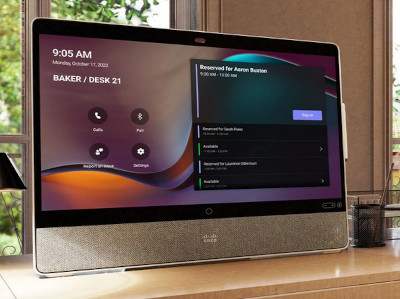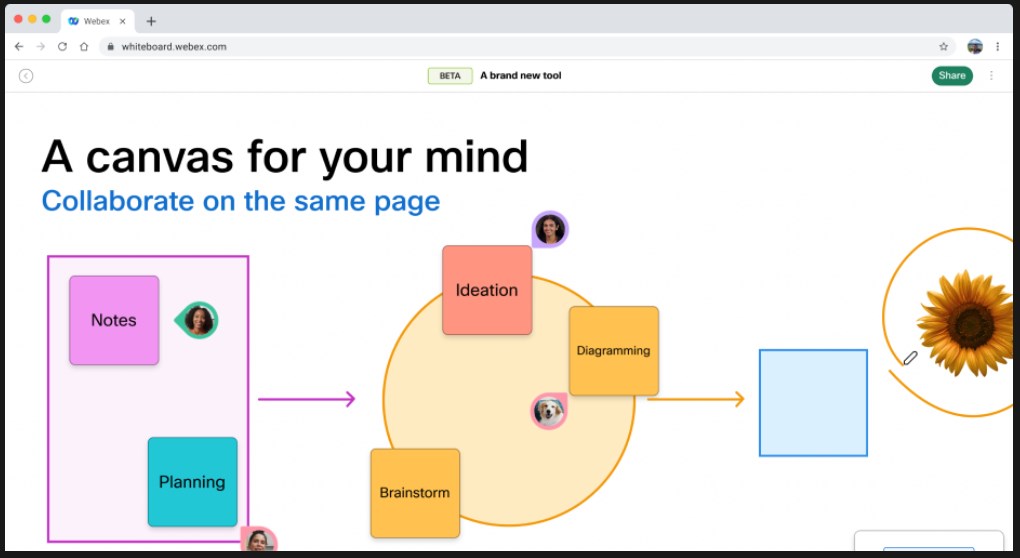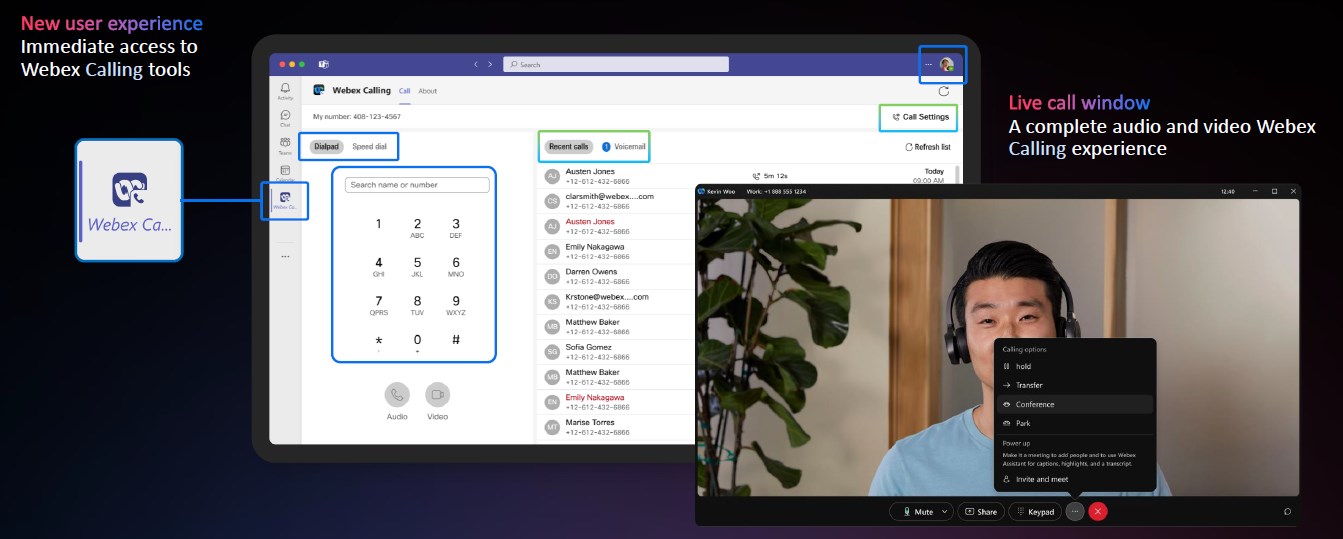I like Cisco. Yes – I admit it. I am a Cisco fan and have been for decades. I use Cisco products in my office, and I have often recommended Cisco to clients.
Last week, I attended a two-day Webex Analyst Open House at Cisco’s office in San Jose, California. This event offered ~ 60 analysts and press a preview of the announcements that would be made at the WebexOne event a few days later.
This analyst event included a ton of interesting sessions, numerous product demos, and insightful one-on-one meetings. From my perspective, this was definitely time well spent.
WebexOne Collaboration Announcements
It’s clear that there’s no time to rest at Camp Webex. Listed below are the key collaboration announcements from the Webex Analyst Open House (and the first day of WebexOne).
#1 – Cisco / Microsoft Partnership
We covered this announcement in great detail within our Oct 14, 2022 research note.
Essentially, some of Cisco’s meeting room video systems will soon support two operating modes – Webex mode and Microsoft Teams Rooms mode.
This means customers with MTR-capable Cisco video devices can enjoy native Webex calls and native MTR calls back-to-back, without having to reboot the device.
And YES – this is a big deal.

#2 – Cisco Room Kit EQ
At WebexOne, Cisco announced a new meeting room video conferencing system dubbed the Cisco Room Kit EQ.

Room Kit EQ is a “split-system” solution, including a video bar with mics, speakers, and multiple cameras, and a separate compute device (a.k.a. “codec”) offering numerous inputs and outputs.
Key features of the Room Kit EQ include support for three displays (great for larger rooms), the ability to connect external mics to the system, support for higher video frame rates, and advanced AI capabilities (e.g., noise reduction, people focus video layouts – see screenshot below, and more).
There are several noteworthy elements within the People Focus layout.
- The system discovered the participants in the meeting room and placed them each in separate video windows. We call this function “people framing.”
- The system zoomed in and cropped the image of the top left participant in the top image to provide a better view of this person.
- The system cropped the image of the bottom left participant in the top image.
- The system used a 6+1 (6 small windows + 1 larger window) layout to maximize the use of the screen real-estate.
These functions combined offer better “views” of the meeting room participants. Within the industry, this is referred to as “meeting equity” or “equality.”

Room Kit EQ will also support dual-mode operation, meaning that it will support native Webex and Microsoft Teams meetings.
#3 – Hybrid Workspace Blueprint
To help customers create highly effective, Cisco-powered (of course) hybrid work environments, Cisco is releasing a Hybrid Workspace Design Guide. This guide leverages Cisco’s learnings from the build-out of its own NYC office and covers meeting rooms, collaboration, networking, security technology, smart buildings, and more.
We obviously can’t comment on this Design Guide until we see it with our own eyes, but in general, we’re in favor of all tools that help end-user customers make informed decisions.
#4 – New Whiteboard App
Cisco is releasing a new Webex Whiteboard app within the Webex Suite. This new app will allow anyone to start, join, and contribute to a whiteboard session from an Internet browser, the Webex App, or a Cisco device.

Notably, these whiteboarding sessions can also include Slido polls, and the content can be saved and shared with others.
We should also mention that the new Whiteboard App will not impact Webex’s integration with the Miro and Mural visual collaboration platforms.
As an aside, Cisco (and many other vendors and even industry pundits) is positioning e-whiteboarding as a key hybrid work requirement. Unfortunately, today, this seems like wishful thinking. Our recent surveys and interviews of collaboration decision-makers and channel partners indicate that e-whiteboarding is of interest to a relatively small portion of information workers.
But, on two positive notes:
- The demand for e-whiteboarding is expected to grow in the next 2 – 3 years
- Many users who have made e-whiteboarding and visual collaboration a part of their workflow consider it indispensable.
FWIW – we’re pleased to see Cisco invest in this area as we find it very difficult to express complex ideas and concepts during video meetings.
#5 – Webex Calling within Microsoft Teams
Customers can now access Webex Calling from within the Microsoft Teams client.

Previously, dialing a Webex call from within Teams redirected users to a different app. That is no longer the case.
Users also gain access to Webex Calling controls, including hold, transfer, conference, park, and more.
#6 – Audio Watermarking
Virtual meetings are a key part of hybrid working, and today’s meetings are more secure than ever before. Unfortunately, a major security loophole remains. Namely, there is no way to keep authorized meeting participants from making unauthorized meeting recordings.
Cisco announced that audio watermarking will soon be available within Webex. Once enabled, the audio watermarking feature tags each outgoing audio stream (meaning the stream traveling from the Webex platform to each participant) with a unique marker that cannot be heard by the human ear. Whenever a person records the audio of a meeting, they will also record the marker.
If an unauthorized meeting recording is discovered (e.g., posted on a website or attached to an email), the Webex Control Hub can decode the marker and provide the name of the Webex meeting participant whose stream was recorded.
Cisco is not the first company to offer audio watermarking. In 2020, Zoom released audio watermarking to its users. However, as far as we know, Zoom does not allow users to decode the marker on their own. Instead, users must send the unauthorized recording to Zoom to be analyzed. Given the option, we’d certainly prefer the Cisco (meaning self-serve) approach.
#7 – Webex Suite
Before this event, we assumed Cisco wanted customers to sign up for Cisco Webex. It turns out we were wrong. Cisco’s wants customers to sign up for the Webex Suite.

When first announced in mid-2021, Webex Suite included calling, messaging, and meetings. Today, Webex Suite also includes polling and events (the ex-Socio platform).
Cisco has priced Webex Suite to be significantly lower (~ 40%) than the combined cost of its various parts. And Webex Suite Enterprise customers enjoy up to a 50% discount on collaboration devices.
Recon Research Comments and Opinions
Cisco is churning out Webex features and capabilities at an amazing rate. And based on the current roadmap, the R&D team isn’t planning to rest on its laurels. But is it possible for a vendor to over-innovate, over-enhance, or over-improve its solutions? Stated differently, is it better for a vendor to announce 3 or 103 new features? Honestly, I’m not sure. What I can say is that Cisco leaned heavily toward the 103 mark (or perhaps the 303 mark) during last week’s Analyst Event.
To be clear – this was an excellent event. Cisco worked very hard to prepare for our arrival, and it showed. Vendors are often concerned about not having enough to say to make such an event worthwhile. That certainly wasn’t the case here. But somewhere along the way, at least for us, the key themes (see the seven key collaboration announcements above) were lost in a sea of details, demos, and customer panels.
Question: Why is Cisco on such a feature tear?
Answer: Cisco wants to prove to the world that today’s Webex is not the same Webex from just a few years ago.
Early in the pandemic, when users complained about Webex call quality (and Teams and Zoom call quality for that matter), Cisco took those comments personally. Very personally. So much so that Cisco now thinks it must prove to the world that Webex is a real contender. In this regard, Cisco is off base.
In general, we are NOT hearing from customers – or channel partners – or the industry at large – that Webex can’t hold its own. Au contraire. Many people we talk to believe Webex offers the best user experience in the industry.
Cisco does not have to convince the industry that Webex is good enough. It’s more than good enough. Enough said.
Instead, Cisco should educate the market, using simple, easy-to-understand, and easy-to-remember messaging, on the role of Webex in today’s hybrid work environment. What does this mean in practice? Focusing on a handful (maybe three to five) important points that really matter instead of presenting 200+ slides about Webex features and capabilities.
Furthermore, as we’ve said before, Cisco should not try to convince customers to shift from one platform to another. Winning such a battle would be difficult, time-consuming, and likely very expensive. A better path would be to help customers (and prospects) understand how Webex fits in alongside other solutions.
Yes – we understand that winning only some of an enterprise’s communication stack is not as rewarding (or profitable) as winning the whole deal. But ball games (and enterprise customers) are won with singles and doubles, not home runs.
We should note that Cisco’s upcoming support for Microsoft Teams Rooms software on Webex video devices is definitely a step in the right direction.
Along those same lines, Cisco should resist the temptation to pitch the rest of its portfolio when the customer is asking for just one thing (e.g., meetings, calling, or collaboration). To be clear, we’re not commenting on the merit of Cisco’s security, networking, or contact center offerings. We’re simply suggesting that Cisco keep things simple to get in (or stay in) the door. Then, when – and if – the time is right, Cisco can try to expand the discussion to include its other offerings.
Summary / Concluding Thoughts
Webex is still the real deal. It’s feature-rich and highly extensible. And the recent Microsoft partnership and other announcements make an already strong story even more compelling. They don’t have to sell us. We’re already on board.
But Cisco’s story is as confusing as it is powerful. Confused channel partners don’t represent vendors effectively, and confused customers don’t sign contracts.
Overall, we applaud Cisco’s ongoing investments in Webex and its collaboration devices. However, we think Cisco would do well to simplify its messaging and help customers understand the three to five (no more please) things it really stands for — not just the plethora of features and functions it brings.






